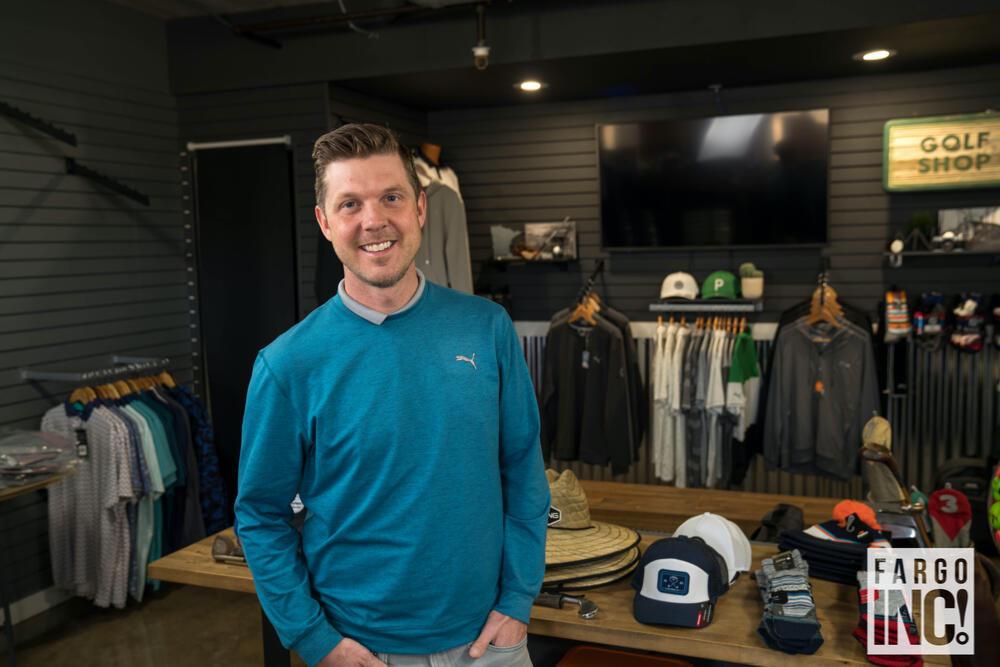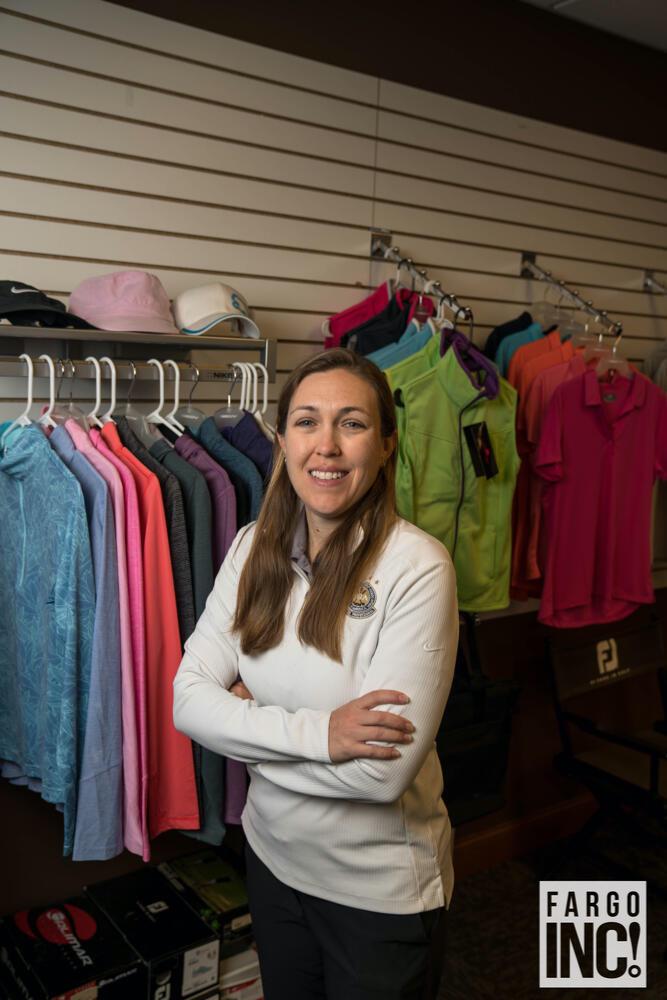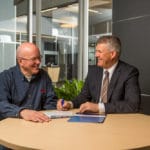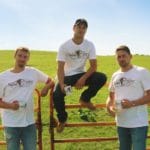“I’m kind of a golf hippie,” Chris Larson says as he glances out the large window in his office overlooking the tenth tee at Moorhead Country Club (MCC).
He wants people to stop worrying about whether their swing is worthy, whether their clothing is acceptable. “Golfers should enjoy playing a calm game in a natural environment. It’s beautiful here and I hope we offer an atmosphere where people can abandon their preconceptions and truly appreciate the experience of it.”
Larson is the head golf professional at MCC, a private club that has seen its membership soar in recent years like a Bryson DeChambeau tee shot. “I want people to be comfortable here.”

Lisa Schwinden is the head golf professional at Osgood Golf Course on Fargo’s south side. As North Dakota’s only female member of the PGA of America, she knows something about taking on golf’s traditions. She also knows that Osgood’s women and junior programs are busting at the seams.
“We focus on making the game accessible. People want a social environment that allows them to enjoy their friends, spend time outdoors in the beautiful North Dakota summers, and not worry about their scores or whether they have the rulebook memorized.”
Larson and Schwinden are part of a new generation of golf club professionals focusing on community and a relaxed, social atmosphere.
“People always ask me how to get more kids interested in golf,” Schwinden says. “It’s simple, but not easy. What do kids like? They like to hang out with their friends and have a good time. So, you create opportunities for them to be social and have fun. Golf does not need to be a solitary endeavor, you against the course. It can be that, but it can also be a less stressful, more communal activity.”
“I always try to remember why I fell in love with golf in the first place. It was because all my friends were into it. The golf course was our sandlot. It’s just what we did,” Larson says. “It was organically fun. No one had to convince me to like it or to want to get better at it. It naturally became one of the main focal points of my social life growing up.”

Culture Changes Catch Up To Golf Tradition
Golf professionals didn’t always talk this way.
For a game invented by Scottish shepherds whiling away the hours on the sandy land linking pasture and sea, golf developed a rigid formality and hierarchy over the ensuing centuries. The cost, time and difficulty of the modern game made it prohibitive for many.
“Golf is intimidating,” Schwinden says. “First, it’s a hard game to master. Then, people see the equipment and the clothing and the cost and the rules, and it’s overwhelming. We’re trying to cut through that to be more open and inviting.”
While Larson and Schwinden respect and honor the traditions of a game that has fed their passion and given them careers, they also recognize 21st century American culture is more focused on experiences, balance and interconnecting all facets of their lives.
“The worst thing a beginning golfer can do,” Larson says, “is strictly follow the rules and keep score.”
Americans have a nearly inexhaustible number of recreational choices, and are willing to spend their disposable income to engage in them.
Time will tell how the post-pandemic world will sort itself out, but signs point toward even greater desires for social engagement and interconnected lives.
Work life flows into personal life, and athletic activities flow smoothly into social and work activities. Silos and compartmentalization disappear. There is no work life, personal life, family life or recreational life. There is only life.
That’s why golf’s rebel pros like Larson and Schwinden aren’t betting on the traditions of the game to attract new participants to the game.
“It’s a marketing challenge,” Larson says. “People, especially kids, already love golf. Some of them just don’t know it because they haven’t tried it or they haven’t been in
the kind of environment where they were able to thrive. We have to create opportunities for them to discover it.”
“You can’t invite people into the game and then put up barriers,” Schwinden says. “That’s not what people respond to these days.”
Acceptance and status in 21st century America are conveyed through a flatter social hierarchy. This attitude is expressed many ways in modern golf. Music blasts from Bluetooth speakers on a golf cart, and team formats are all the rage.
Schwinden says participation in Individual format competitions is down. Team and league formats fill up quickly.
Growth In A Declining Market
Tiger Woods’ victory at the 1997 Masters brought unprecedented attention and growth to the game of golf. But that burst did not sustain itself. There were 6.8 million fewer
golfers in the U.S. in 2018 than there were in 2003, according to the National Recreation and Park Association.
While 2020 was a banner year for golf courses everywhere because of the game’s relative safety as a recreational activity during the COVID-19 pandemic – “It perfectly checks all the boxes for social distancing,” Schwinden says – MCC and Osgood have both seen consistent growth for years.
“We have 400 members now,” Larson says. “We used to think 320 members was full capacity for our club. The surge of new members has allowed us to rethink the structure of our membership and the services we can offer.”
Schwinden says her Tuesday tee times dedicated to women’s league fill up quickly every week, and she’s continually adding more sections to her junior leagues and lessons programs.
Early Opportunities

Golf was a natural part of the childhood experience for Schwinden and Larson.
They were both north Fargo kids, with Schwinden growing up just a block south of El Zagal, Fargo’s par-3 course. She and Larson say they spent countless hours there with friends improving their games, but more importantly, just having fun.
Both also credit long-time Edgewood Golf Course pro Greg McCullough with giving them early chances to see what a career in golf might be like.
A multi-sport athlete at Shanley High School, Schwinden’s first paying job was at Edgewood working the driving range and then pro shop. Similarly, Larson’s first opportunity came from long-time MCC pro Larry Murphy.
Both learned the ropes from these local legends and others, from golf operations to selling merchandise to teaching lessons. “The Fargo golf world is a tight-knit community,” says Larson. “Everyone is so helpful and supportive.”
After nine years as an assistant pro at MCC, Larson became the head professional there, his dream job.
Schwinden was named Osgood’s first head pro when the brand-new course opened in 2005.
Pros Need Business And People Skills Over Golf Ability
Golf club professionals don’t just play golf all day. And they don’t hobnob with the playing professionals you see on TV. “No, I don’t know Tiger Woods,” Schwinden wryly offers.
Schwinden and Larson both say business acumen is the most important trait needed to do their jobs well. That includes people skills.
“Our jobs are incredibly diverse,” says Larson. “One minute, I’m putting a new grip on a club. The next I’m dealing with a member’s comments about the pin position on a green. Then, I go to a management meeting where I explain and justify my budget. You need a wide variety of skills to succeed at this job.”
“I wish I had more business training,” Schwinden says, “because that is where
I spend the bulk of my time – marketing, developing programs, hiring employees, taking care of the accounting, completing forms. And I’m a journalism major!”
“Starting out, I thought it would be much more about teaching lessons and interacting with customers. I do those things, but the business aspects are constant,” she says.
Building A Successful Niche
Larson and Schwinden continually assess the landscape and try to offer what people want – new programs, events, merchandise and other amenities.
“What advantage do we have?” Larson asks himself. “We try to offer things people can’t get other places. That starts with our logo. Members want merchandise with the club logo on it.”
He also offers brands customers won’t find elsewhere. Boutique golf brands are hot right now, and offer opportunities that golf megabrands like Puma, Nike and Ping might not. Lately, he’s been stocking non- golf items like the Minnesota made Duke Cannon line of colognes and soaps.
“It’s a novelty here. People don’t expect it. And we’ve done really well with it. We try to surprise our members sometimes with the products we bring into the pro shop,” Larson says.
In another sign that today’s golfers are looking to blend all aspects of their
lives, golf clothing is trending toward the athleisure market – pants that work for 18 holes in the afternoon and then transition to a night on the town afterward, and spikeless golf shoes that are indistinguishable from other street shoes.
It’s all just one big life.
Golf technology is also surging right now. Larson says GPS yardage finders are an expected amenity these days, and MCC is adding them to their carts this summer.
Following the trend in other sports, golfers are increasingly interested in measuring their performance – things like club speed, ball speed, launch angle and spin rate. That’s why MCC’s two golf simulators are booked solid and members are calling for more simulators, more available times.
Cold weather simulator leagues have been a big revenue boost for MCC. “People love the latest tech, and they love to hang out with their golfing buddies in the dead of winter,” Larson says.
Schwinden is known for her focus on programming for women and kids, because that’s where the growth opportunities lie. Even though she’s the pro at a public golf course, she develops and manages her own leagues and lessons programs, which she promotes through GolfwithLisa.com. “The Fargo Park District allows me to take this wherever I see an opportunity. And the success or failure is on me,” she says.

What’s Next?
“We have to keep growing the pie,” Schwinden says. “We need to create more paths for people to get into the game at all levels.”
Suite Shots, a self-described “golf entertainment facility” is set to open in south Fargo in coming months. Larson and Schwinden are looking forward to it.
“It’s a very low-risk opportunity for people to try the game, if they don’t consider themselves golfers,” Larson says. “It follows the spirit of what we’re trying to do to make the game more accessible.”
“Golf in North Dakota is not like golf in Arizona,” Schwinden says. “We normally need to cram a year’s worth of activity into six months. Indoor and heated facilities make it more of a year-round activity.”
Like many industries, golf is changing rapidly. Customer expectations are evolving, and golf professionals like Larson and Schwinden are ready to respond.
“I’m not stuck in the past or tied to tradition,” Schwinden says. “If there’s an idea and we think it will work, let’s try it. If it grows the game and people enjoy doing it, I’m all for it.”
That’s golf pro rebel talk.








